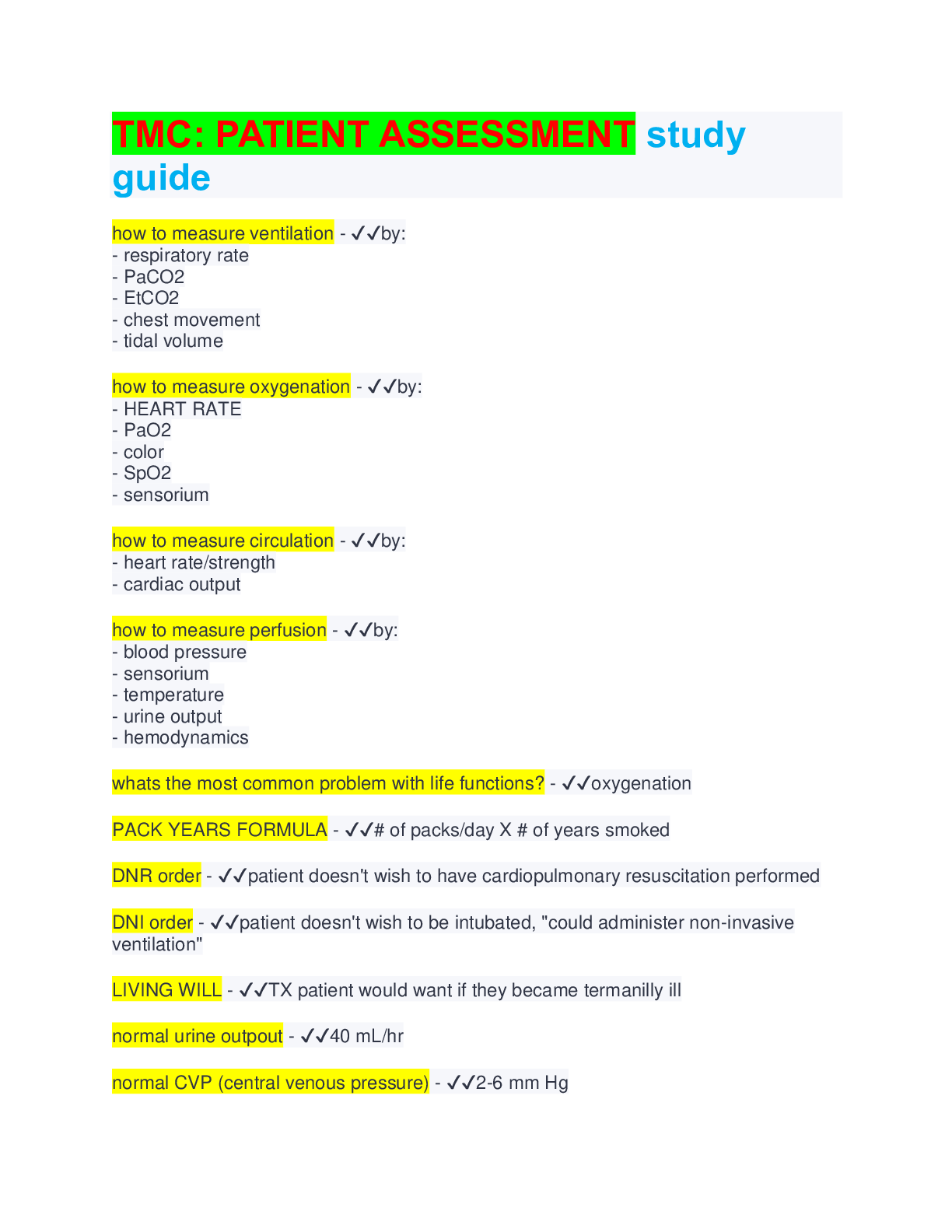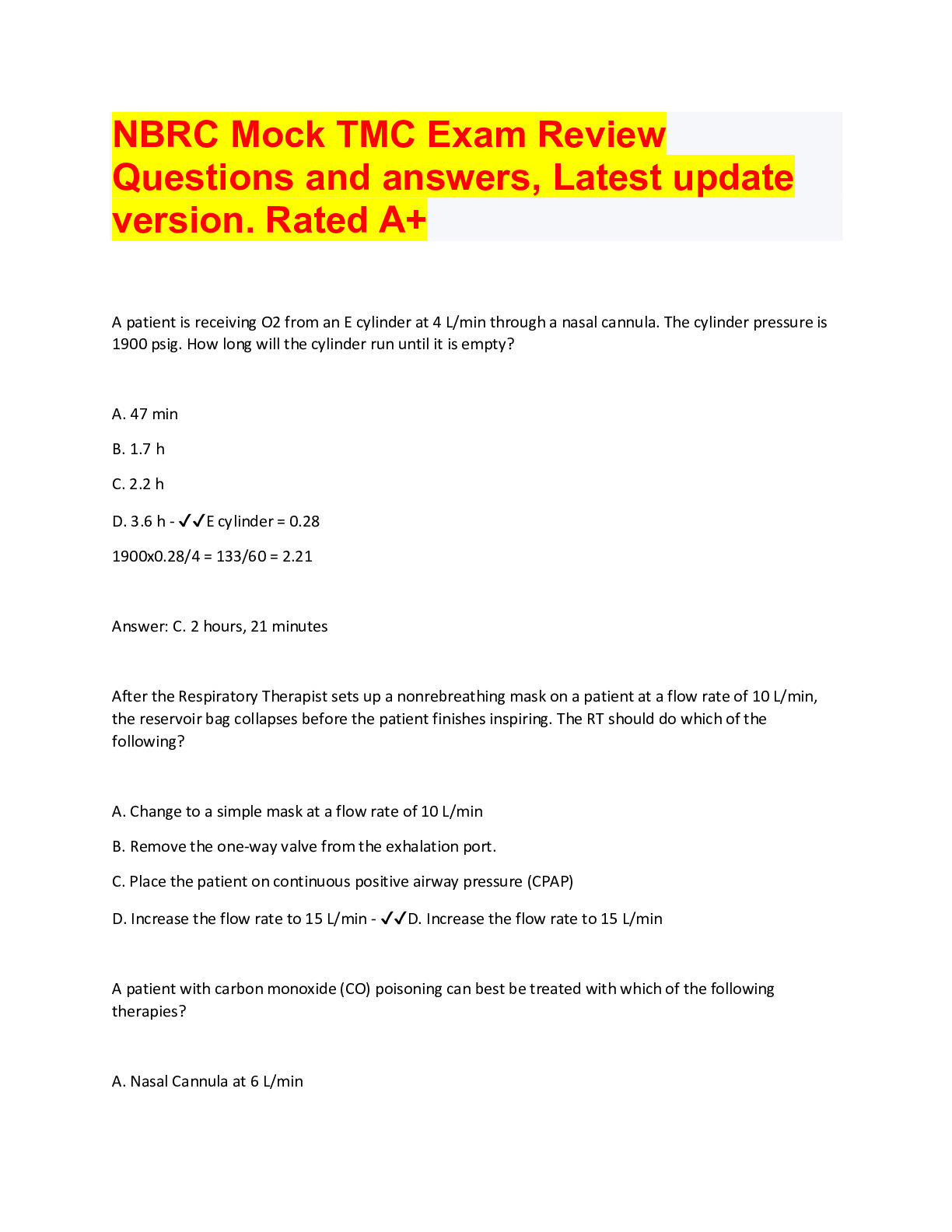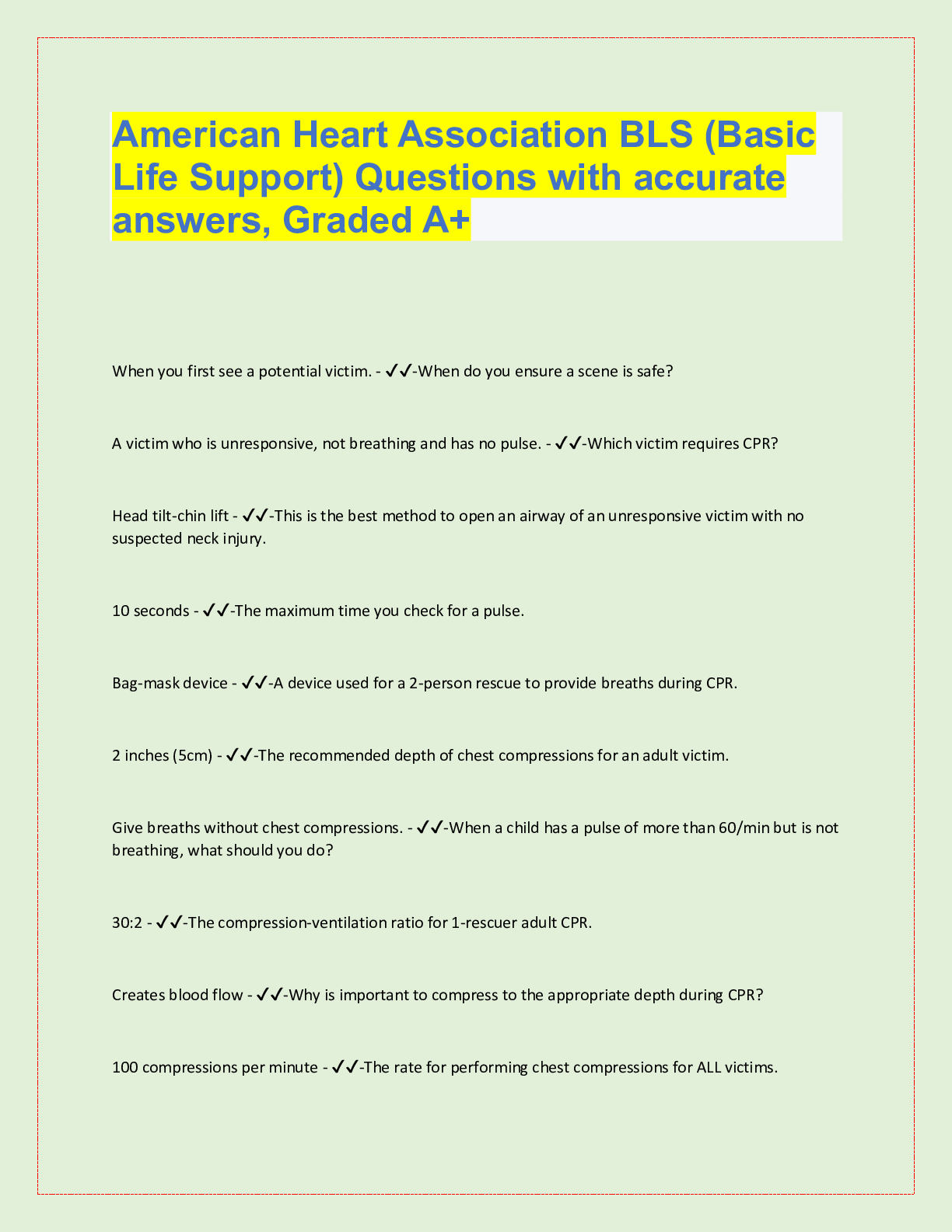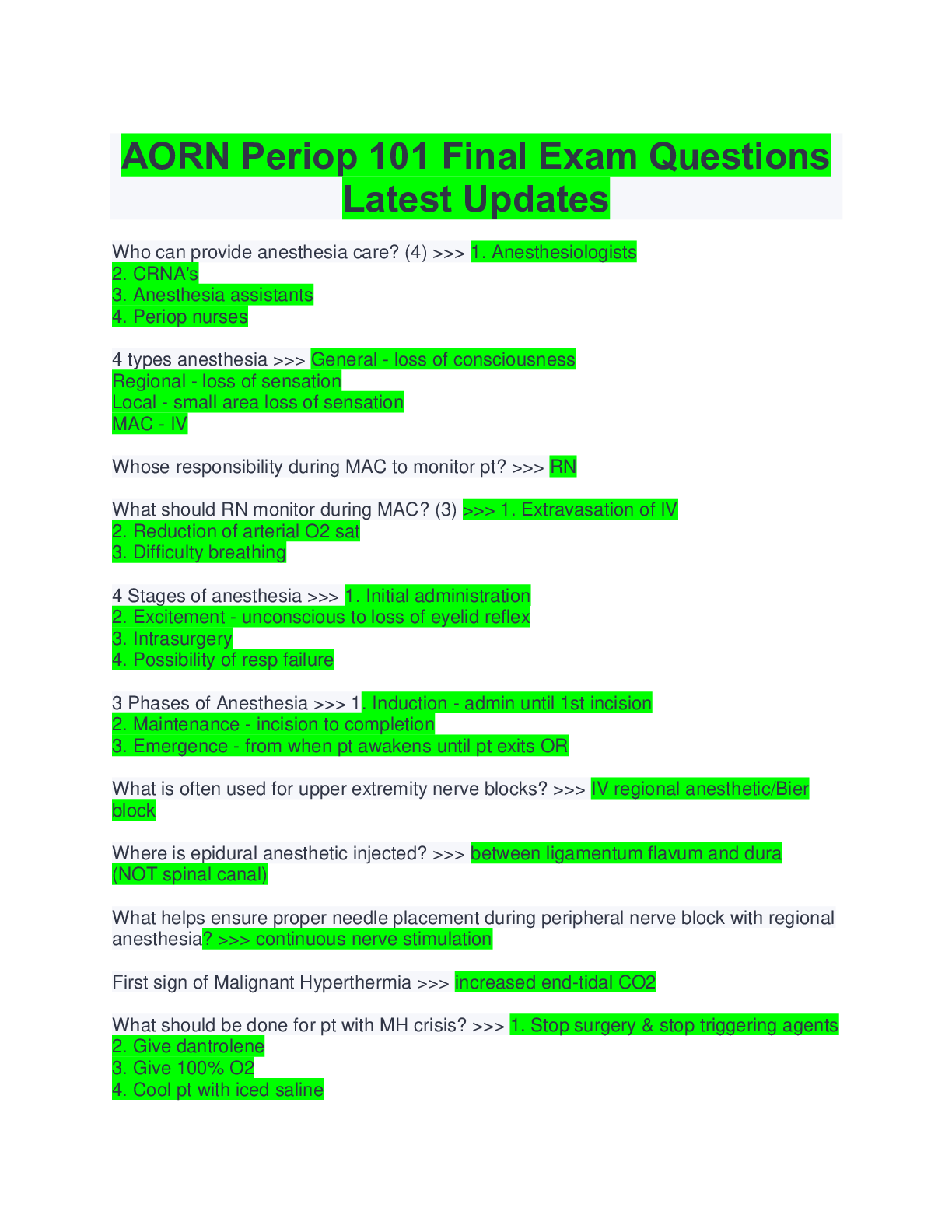*NURSING > QUESTIONS & ANSWERS > TMC: Quality Control Procedures. Latest Version. Comprehensive. 2022 (All)
TMC: Quality Control Procedures. Latest Version. Comprehensive. 2022
Document Content and Description Below
Analytical phase of blood gas/hemox measurement involves 4 key elements - ✔✔1. Analyzer calibration 2. Actual sample testing 3. Interpretation of the results 4. Ongoing review of QC and profici... ency testing results Calibration - ✔✔Process whereby the response of an instrument is compared and adjusted to a known standard It involves adjusting the analyzer to ensure that its response is accurate and linear Today's machines have automated calibration routines at regularly scheduled intervals that take place in the backgroud Calibration Verification - ✔✔Involves analysis of pre-prepared control media, typically 3 diffferent levels of control media Done every 24 hours Should be done for any instrument maintenance or if there is a question regarding instrument performance. To conduct comprehensive quality control, you need to record and continuously monitor data using: - ✔✔Statistical QC Random Error - ✔✔ Bias Error - ✔✔ If a control measure consistently falls within 2 SD's of the mean, or limits, indicates the analyzer is in - ✔✔Control Control measures that fall outside of the 2 SDs are considered - ✔✔Analytical errors Frequent random errors indicate a lack of: - ✔✔Precision and indicates the instrument is "out of control" What should you do if you have a random error? - ✔✔Reanalyze the sample after performing a two-point calibration Standards used to calibrate blood gas analyzers - ✔✔1. Precision gases 2. Buffer solutions With known pH, PCO2, and PO2 values Hemoximeter calibration involves measurement of standard solutions with known - ✔✔THb HbO2 COHb MetHb Positive bias - ✔✔The precalibrated response of the analyzer is linear, but the analyzer response is greater than the known value or calibrated response. Calibration requires matching the slope and the offset This requires a two point calibration: One Low and One high known value are used Electrochemical gas analyzers have an accuracy of: - ✔✔+/- 2% When testing a vents operation the actual O2 concentrations delivered by the device should be w/in this 2% of that set on its FiO2 control when using a calibrated O2 analyzer When checking a galvanic fuel cell O2 analyzer you determine the device fails to read 100% when exposed to pure O2 - ✔✔Change the analyzer's fuel cell When reviewing blood gas statistical quality control data you note a progressive positive bias error in the instrument's PCO2 measurement, systematic or bias errors are usually due: 1. to contaminated buffers 2. incorrect calibrating gas concentrations 3. incorrect analysis procedures 4. component failure - ✔✔Analyzer component failure Internal Statistical Quality Control - ✔✔Uses statistical and rule based procedures to help detect, respond to, and correct instrument error by plotting results of control media analyses and comparing them to statistically derived limits - usually within 2 SD Control results that fall outside 2SD are considered analytic errors On a PO2 calibration curve (Pre-calibration vs. desired) for a manually callibrated blood gas analyzer, the output readings on the pic are consistently higher than the actual (desired) input and worsening at higher levels. What do you do? - ✔✔Calibration will require both an offset (balance) and gain (slope) adjustment Calibration Verification - ✔✔Analyzing of control media (in the same manner as patient samples) to confirm that the calibration of the instrument has remained stable throughout the lab's reportable range. Automated calibration - ✔✔Blood gas analyzers regularly calibrate themselves by adjusting each electrode's output signal when exposed to media having known values (pH, CO2, O2) Two categories of Analytic Error in Statistical QC for ABG - ✔✔1. Random 2. Systematic Examples of Imprecision errors - ✔✔Sample mishandling Sample contamination Chance statistical or probability What do you do if you have a random error? - ✔✔Rerun the control Repeat analysis on different instrument Examples of Systematic/Bias Errors - ✔✔Contaminated buffers Incorrect gas concentrations Incorrect procedures Component failure What do you do if you have a systematic error? - ✔✔Perform function check of suspected problem area Repair replace failed components When analysis of an ABG sample taken from a healthy athlete reveals a pH of 7.36, PCO2 45 torr and PO2 of 43 torr, What could be wrong wit this sample - ✔✔Sample admixture with venous blood Venous Admixture: Raises PCO2 Lowers pH Can greatly lower PaO2 To periodically confirm the validity of blood gas analyzer or hemoximeter results - ✔✔Perform a control media calibration verification When a fuel cell oxygen analyzer is reading 18% when exposed to ambient air - ✔✔Start with calibrating the sensor During an extended self-tea you receive multiple failure warnings but you are allowed to bypass them and complete the test - ✔✔take the vent out of service and replace it with a fully functional device when Blood gas analysis/hemoximetry quality control procedure involves plotting the results of the control media analyses on a graph and comparing these plots against derived range limits, control results that fall outside these limits indicate analytic error - ✔✔statistical quality control When looking at a statistical quality control plot from a blood gas analyzer, you notice a downward trend of data points of the last 10 control runs.. What type of error is this? Systemic/Bias or Random What is the most likely cause? - ✔✔Systematic error Likely Buffer contamination When laboratories receive "unknown" samples for analysis on a regular basis which must be analyzed and reported back to the agency. This is called: - ✔✔proficiency testing What is the cause of an error when you are reviewing blood gas statistical quality control data, you note a progressive bias error in the instrument's pH measurement - ✔✔incorrect analysis procedures You run a control solution thru a blood gas analyzer as part of daily quality control the measured high PO2 value is 9 torr outside of the acceptable range, and prior runs were all in range. What do you do? - ✔✔Perform a 2 point calibration and rerun the control This is a random error. [Show More]
Last updated: 1 year ago
Preview 1 out of 12 pages
Instant download

Buy this document to get the full access instantly
Instant Download Access after purchase
Add to cartInstant download
Also available in bundle (2)

All TMC practice questions papers with answers. Bank questions. Download to score A
Most sought TMC revision kits. Guaranteed comprehension/ GRADE A+
By bundleHub Solution guider 1 year ago
$35
8

TMC EXAM BUNDLE, QUESTIONS WITH ACCURATE ANSWERS
ALL VERSIONS OF TMC EXAM PAPERS, BUNDLED QUESTIONS WITH ANSWERS, LATEST UPDATES
By bundleHub Solution guider 1 year ago
$38
16
Reviews( 0 )
Document information
Connected school, study & course
About the document
Uploaded On
Aug 07, 2022
Number of pages
12
Written in
Additional information
This document has been written for:
Uploaded
Aug 07, 2022
Downloads
0
Views
81













